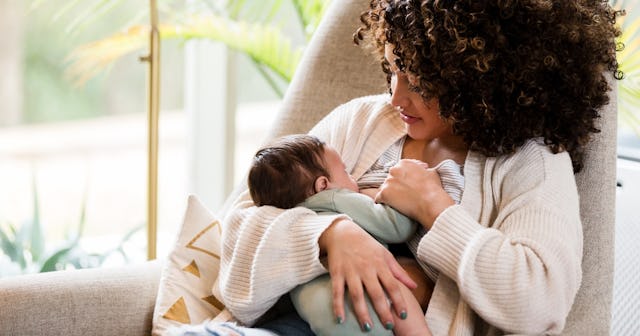How To Treat A Milk Bleb On Your Nipple, Because They Are The Worst

Early motherhood is a beautiful thing, but that doesn’t mean it’s all rainbows and unicorns. In fact, if you’re breastfeeding, it can mean pain, frustration, and yes, milk blebs, or milk blisters, on your nipples. Per Kelly Mom, a milk bleb or blister is nothing more than a blocked pore on your nipple. It happens when skin grows over your milk duct and then your milk is just backed up behind up. Oh the joys of milk production, right? Let’s dive into what this means for you and what you can do to ease the discomfort.
What is a milk bleb?
Milk blebs are thought to be caused by an oversupply of milk, along with any latch and suck issues you’re running into with your baby. But they can also be caused by nipple thrush, or yeast, which appear as tiny white spots on your nipple. If you have more than one milk blister, What To Expect says they were likely caused by thrush. If you have just one, you’re dealing with a blocked pore. Usually, the milk blisters will hurt more when caused by thrush while the ones caused by an oversupply of milk might feel better after feeding or pumping, given that you’ve emptied the duct for the time being.
While milk blisters aren’t something to rush to the doctor for, they can be really painful just around the spot where it is backed up, especially during feedings. They aren’t serious, just a serious pain in the butt. Usually, they will heal on their own within a week or two at most but in the meantime, it’s not easy to deal with. But don’t lose hope, there are some things you can do to prevent and treat milk blebs in the future.
What does a milk bleb look like?
A milk bleb is a tiny white or yellow spot that sits very close to your nipple. It usually looks a lot like a pimple that’s about to burst or a white head. Sometimes, the skin around the bleb is red and swollen, which makes it incredibly painful when breastfeeding. Remember, you should never pop a milk bleb because it can lead to infection.
How do you prevent milk blisters?
You can prevent milk blebs from happening, but you have to plan ahead a little bit. These are some steps to take to make sure one never plagues you again.
- Pump between feedings. Because they can be caused by blocked milk, you can prevent milk blisters by pumping in off-hours. Your breasts can get clogged as your baby grows, starts sleeping through the night, and/or their feeding schedule changes. So getting up to pump and release your milk will definitely ensure you don’t blister up.
- Hydrate. Hydrate. Hydrate. Drink a ton of water, not just because it’s good for you, but because it flushes your system and unclogs your milk duct.
- Hand express. After a feeding, you can hand express the ends of your supply so it doesn’t clog your duct. You can also wash your nipple after feeding with soap and warm water in order to prevent milk blisters from forming.
- Hold baby in a comfortable position. Make sure you hold your baby in a feeding position that feels comfortable for the both of you. Some positions can lead to irritation and put excess stress or tension on your nipples.
- Dry off and moisturize your nipples. After each feeding, clean and dry your nipples to keep your pores unclogged. To keep them moisturized, rub them with olive oil.
How should you treat your milk blisters?
Again, a milk bleb or milk blister will often heal on its own, but there are some easy steps to take to treat it yourself, at home. Per What To Expect, if the milk bleb doesn’t heal within a couple of days, especially after these steps, you might want to check in with your medical provider. But try these steps to unclog your milk blister first.
- First, apply a warm, wet washcloth (or something similar) over the milk blister for 10 to 15 minutes, right before a feeding.
- Before breastfeeding, make an Epsom salt solution using two teaspoons of Epsom salt and one cup of hot water. You can either let your breasts soak in it or wrap them in a cloth soaked in the salt solution. This will help your milk ducts open up and heal any irritation or soreness. Try to do this treatment at least four times a day.
- Then, nurse your baby, because suckling might actually open the blister for you. If you are experiencing a lot of pain, you can take Tylenol or Advil beforehand, but ask your doctor first.
- If it opens up, you should wash it with some warm soap and water and then use an antibiotic ointment over it, just like you would a mild scrape or open wound.
If you don’t have the wherewithal to do all of this on your own and you’re in a lot of pain or worried about the milk blister, you can always go to your doctor and have them open up the blister with a sterile needle. Remember, milk blisters are nothing to freak out about, but they are painful, so do what’s right for you and your well-being.
This article was originally published on